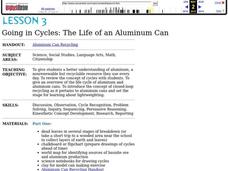Brine Shrimp: Getting to Know a Salt Water Arthropod
Gather small observations of arthropods. Using brine shrimp, pupils observe the life cycle of arthropods. Learners set up saltwater aquariums and observe the brine shrimp over a three-week period. To finish, they compare and contrast how...
Alabama Wildlife Federation
Butterflies without Borders
Some living things go to extreme measures to avoid the cold. A three-part activity guides learners through the migration of the monarch butterfly. After studying the life cycle of the monarch butterfly, pupils learn the process of...
Sea World
Ocean Discovery
Immerse your young marine biologists in the world of marine animals. The lesson includes several activities that are age-appropriate for preschoolers and kindergartners, including coloring pages, gluing feathers and sand onto paper...
Curated OER
How Much Water is Available in the Atmosphere for Precipitation?
Students explore the relationship between the amount of water in the atmosphere available for precipitation and the actual precipitation observed by satellite. They examine seasonal changes in precipitation. They practice using Internet...
Carnegie Mellon University
Introduction to Climate
Begin a full instructional activity on climate change by demonstrating how carbon dioxide gas contributes to increased temperatures. Be aware that pressure inside the antacid-containing bottle in Activity 2 may cause the lid to fly off;...
National Park Service
Weather Patterns of the Pacific Ocean
How do oceans affect weather patterns? Learners define vocabulary associated with dew point, topographical lifting, condensation, and formation of clouds and precipitation as they explore the weather in the Pacific Northwest. They also...
Purdue University
Trees of the Midwest
All trees are not created equal. A set of three wildlife conservation lessons has learners examine the characteristics of individual trees. They look at the life cycle of the tree using a story and reference a field guide to identify...
Curated OER
The Dragonflies of Summer
The best thing about dragonflies is that they make great topics for informational texts. Get those readers excited with a fun and interesting insect-related text passage that can help them increase their comprehension skills. As children...
EngageNY
Modeling Riverbeds with Polynomials (part 1)
Many things in life take the shape of a polynomial curve. Learners design a polynomial function to model a riverbed. Using different strategies, they find the flow rate through the river.
Read Works
We Need Freshwater
Why do we need freshwater? Because freshwater sustains life. After reading a three-paragraph passage about the importance of freshwater, first graders respond to the article by answering comprehension questions. The resource includes...
Nuffield Foundation
Investigating the Effects of Biochar on Soil Fertility
Breathe some new life into charcoal. Scholars use biochar to improve soil fertility. They test the effectiveness of this addition by conducting an experiment with soil having 0%, 2%, and 4% biochar.
Smithsonian Institution
Water/Ways: The Poetry of Science
Water is the source of life. It appears in poetry in both peaceful and torrential descriptions; it appears in earth science in its liquid, gaseous, and solid states. Combine these interpretations of our planet's most precious and...
Curated OER
Little Bees, Big Potential
After reading an article on the alfalfa leafcutting bee, learners chart its characteristics alongside those of the honeybee. Then they draw the leafcutter lifecycle. The article provides fascinating reading when studying the role of...
Curated OER
Periodical Cicada Survival
Young scholars explore defense mechanisms involved in predatory/prey relationships.They engage in a discussion about predatory/prey interactions. They reflect on the life cycle and behavior of the cicada.
Curated OER
On the Trail of the Hudson's Migratory Fish
Using data related to the fish in the Hudson River area, learners calculate distance, elapsed time, and growth. They learn about migratory fish, the life cycle of a fish, analyze a map, and answer questions.
Curated OER
Skeeterville
Students explore insect life by participating in a role-playing activity. In this mosquito life instructional activity, students listen to a role-play scenario in which they must protect a town from mosquitoes by creating a field guide...
Curated OER
Protests against Bush
Non-violent conflict resolution is the focus of this instructional activity, which addresses the protests against President Bush in the UK (2003). Students list the strengths and limitations of non-violent conflict resolution, and chart...
Curated OER
Butterflies are beautiful
Second graders explore butterflies. They discuss the types of butterflies that are found in Indiana. Students learn what kind of plants are needed to start a butterfly garden. They study the four life stages of a butterfly.
Curated OER
Go Bug!
Second graders explore the lives of insects by participating in a card game. In this metamorphosis instructional activity, 2nd graders define several scientific vocabulary terms associated with insects and identify the different life...
Curated OER
Going in Cycles: The Life of an Aluminum Can
Students investigate the manufacture of aluminum cans and consider the energy and resources saved when the cans are made from recycled material. They explore the concept of closed-loop recycling using charts, worksheets and discussion.
Curated OER
Watch Your Step!
Students examine the physical characteristics of insects and spiders. Students research the vaious ways in which insects move. They then observe and record the metamorposis of one of more insects. They complete the lesson by...
Curated OER
Something's Fishy
Students study fish habits and traits. In this marine life lesson, students complete four learning centers of a fish memory game, a fish habitat study, draw and glue fish craft activity, and a fish read-a-thon. Students complete their...
Curated OER
Plant Life Cycle of Pumpkins
Students identify the life cycle of different plants. They complete a life cycle wheel for pumpkins. They draw a picture to go along with each description. They put the life cycle into the correct sequence to complete the lesson.
K-State Research and Extensions
Water
How are maps like fish? They both have scales. The chapter includes six different activities at three different levels. Scholars complete activities using natural resources, learn how to read a map, see how to make a compass rosette,...
Other popular searches
- Life Cycles
- Animal Life Cycles
- Butterfly Lifecycle
- Reptiles Life Cycles
- Life Cycles of Stars
- Spiders Life Cycles
- Life Stages
- Insect Life Cycles
- Lifecycle
- Butterfly Life Cycles
- Plant Animal Life Cycles
- Life Cycles of Animals

























